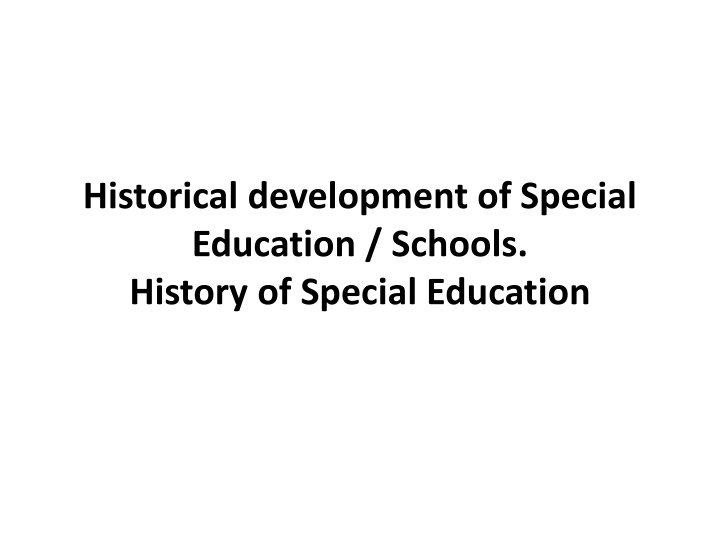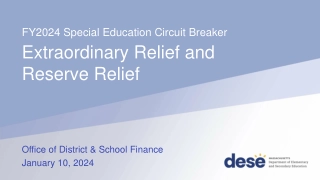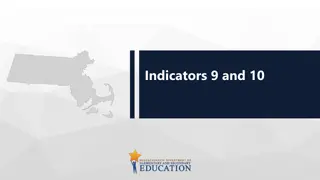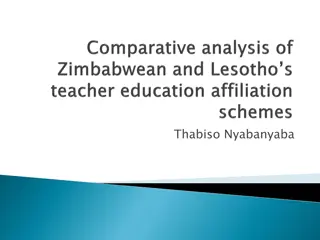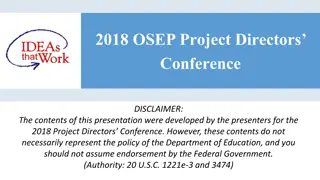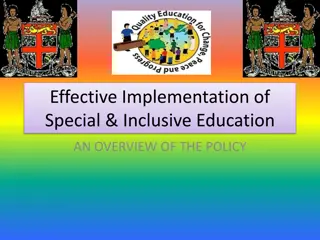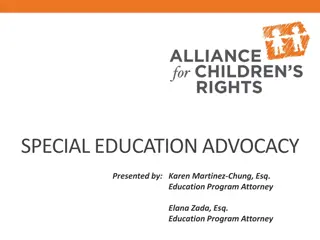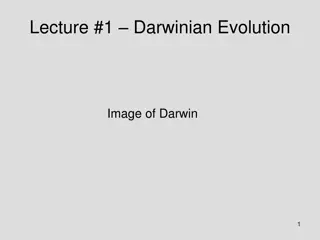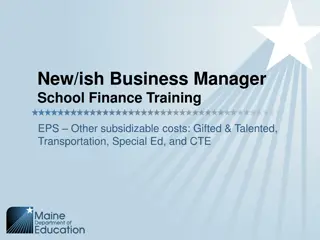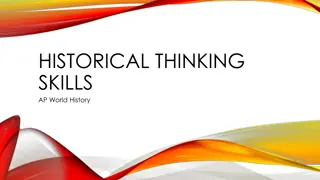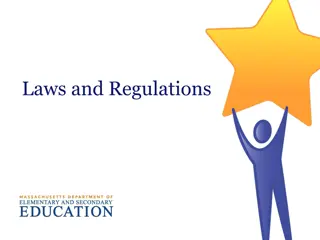Historical Development of Special Education: Evolution Through Time
Prehistoric societies had varying approaches towards individuals with disabilities, with some cultures valuing them while others resorting to harsh measures. The ancient Greeks and Romans made initial attempts at understanding and treating disabilities. Over time, societies transitioned towards more humane care, with milestones such as the establishment of the first public school for the deaf in 1760.
Download Presentation

Please find below an Image/Link to download the presentation.
The content on the website is provided AS IS for your information and personal use only. It may not be sold, licensed, or shared on other websites without obtaining consent from the author.If you encounter any issues during the download, it is possible that the publisher has removed the file from their server.
You are allowed to download the files provided on this website for personal or commercial use, subject to the condition that they are used lawfully. All files are the property of their respective owners.
The content on the website is provided AS IS for your information and personal use only. It may not be sold, licensed, or shared on other websites without obtaining consent from the author.
E N D
Presentation Transcript
Historical development of Special Education / Schools. History of Special Education
Introduction: Pre historic societies, whose survival could depend on the fitness of each member, did not protect children who were born with defects, generally allowing them to die at birth or in early stages of life. Some ancient peoples, believing that Physical deformities and mental disorders were the result of possession by demons, rejected, punished or killed those who were afflicted. However there is some evidence of persons with disabilities being treated with kindness, or even valued as being possessed of supernatural powers. The ancient Greek and roman societies gave us the first recorded attempts at the scientific understanding and treatment of disability in children.
Some physicians and scholars in these cultures began to look on such conditions as treatable, and although infanticide (killing of children under the age of 12 months) was common, some efforts were made to preserve the lives of children with disabilities. In the Middle Ages, persons with disabilities were used for entertainment. More often however they were derided, imprisoned or executed. During this period the church began to foster humane care for people with disabilities and to provide asylums for them. The renaissance brought a greater belief in the value of human life and laid the groundwork for the popular revolutions that later overthrew the domination of royalty in much of Europe and in America. Interest In educating children with disabilities then grew out of the new humanism of the Renaissance, the belief in the worth of every individual and the associated struggles for freedom for the common man. Concise Encyclopedia of Special Education: A Reference for the Education of the Handicapped and Other Exceptional Children and Adults, Cecil R. Reynolds, Elaine Fletcher-JanzenJohnWiley & Sons, 30-Jan-20
Special Education for individuals with hearing Impairments, started in about 1555 when a Spanish holy-man, Pedro Ponce De Leon taught a small number of children who were deaf to read, write, speak, and to master academic subjects. Another Spanish wrote the first book on the education of individuals who were deaf in 1620.
In 1760 First Free Public School for Deaf: Charles Michel De, a French priest, was really considered the "Father of Sign Language and Deaf Education" because he established the first free public school for the deaf in Paris, in 1760. The First permanent school for the deaf in UK was established in 1767, in Edinburgh by Thomas Braidwood.
Almost in the same time, (In 1767) Samuel Heinicke developed a purely Oral Method of Instruction. Emphasizing the development of Lip Reading and Speaking Skills. Samuel Heinicke s developed by Friedrich Moritz Hill. It was the basis for the Oral method that became accepted practice throughout the world. method, as further
In 1817, Clerc and Gallaudet founded the American Asylum for the Deaf and Dumb (now the American School for the Deaf). In 1864, a college for deaf people was founded in Washington D.C. It was named The National Deaf-Mute College (later "Gallaudet College" (1894), and then renamed "Gallaudet University") in 1986.
In 1839: The first school to integrate deaf and blind students opens. In 1872-76, Bell Invents Telephone Trying To Help the Deaf: Alexander Graham Bell opens a speech school for deaf teachers in Boston. He invents the telephone while trying to develop a mechanical way to make speech visible. Bell reportedly believed that deaf children should be educated orally situations. and in day- school
In 1874, for Adult Education for Deaf: Adult education for persons who were deaf began in New York City in 1874.
In 1782: Improved Amputation (Elimination) Techniques: Edward Alanson, an suggests a change in the way limbs are amputated, resulting in faster healing and less infection. This change has a positive impact on the quality of life for people who are amputees. English surgeon,
In 1860, First Steps in Identifying Cerebral Palsy: In the 1860s, William Little makes the first step toward identifying describing children with stiff and/or spastic muscles in their arms and legs. That particular condition, known at the time as Little s disease (now called spastic diplegia ), is one of the major disorders included in CP. Little also guesses that the condition is caused by lack of oxygen during birth. cerebral palsy (CP) by correctly
In 1900, Education of children with Orthopedic Handicaps and Other Health Problems.: In the US, the first special class for Orthopedic Handicapped children was established in the Chicago Public Schools in 1899 or 1900.
In 1927, Iron Lung To Combat Polio: In 1927 Philip Drinker and Louis Shaw develop the iron lung, a chamber that provides artificial respiration for polio patients being treated for respiratory muscle paralysis.
In 1784 Institution for Blind Children: 1stspecial school was established in 1784 in Paris, to teach the Blind persons. Valentin Huay, known as the father and apostle of the blind, establishes the Institution for Blind Children to help make life for the blind more tolerable. The school admitted students who were both blind and sighted so as not to isolate students who were blind from their peers with sight. It success led to the formation of seven similar schools in the Europe.
In 1829, The first school for children who were blind in the US began. In 1829, Braille Invents the Raised Point Alphabet: Louis Braille invents the raised point alphabet that makes him a household name today. His method doesn t become well-known in the United States until more than 30 years after it is first taught at the St. Louis School for the Blind in 1860.
Mentally Retardation / Mental illnesses
In 1793 Mentally Ill Unchained: Phillipe Pinel, a physician at La Bicetre, an asylum in Paris, removes the chains attached to people with mental illnesses. Some have been chained to walls for more than 30 years. In 1798, working with Mentally Retorted children starts: Jean Marc Gaspard Itard, the French physician started tranining of a boy, who was living with animals.
In 1800, First Medical Classification of Mental Disorders: Phillipe Pinel writes Treatise on Insanity in which he develops a four- part medical classification for the illnesses: melancholy, without delirium, and mania with delirium. major mental dementia, mania
In 1801 Education for Mentally Disabled: Education for children with mental retardation begun with the attempt by a French Physician, to educate an 11 years old boy. Jean-Marc Gaspard Itard establishes the principles and methods used today in the education of the mentally disabled through his controversial work with Victor, the wild boy of Aveyron.
In 1805, Mental Disorders Documented: Dr. Benjamin Rush, considered the father of American psychiatry, publishes Medical Inquiries and Observations, the first modern attempt to explain mental disorders. In 1840, residential rehabilitation program was started in Switzerland.
In 1950, The ARC Champions Abilities of Mentally Retarded: Parents of youth diagnosed with mental retardation found the Association for Retarded Citizens (ARC). The association works to change the public s ideas about mental retardation. Its members educate parents and others, demon- strating that individuals with mental retardation have the ability to succeed in life.
